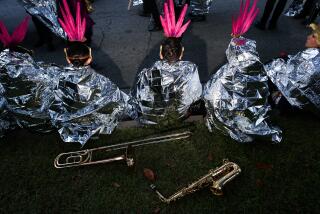Where Rose Parade floats are born
Millions of Americans are familiar with the Rose Parade, the storied Pasadena pageant whose flower-covered floats have dazzled viewers for more than a century.
What’s less known is that most of those rolling creations are produced by a trio of local firms that labor in obscurity most of the year to prepare for a single day in January.
Phoenix Decorating Co. in Pasadena, Fiesta Parade Floats in Irwindale and Artistic Entertainment Services in Azusa are the Rose Parade’s Big Three.
With the Jan. 2 showtime fast approaching, the companies are putting the finishing touches on floats that took months to design and build. On average, each craft costs more than a typical U.S. home.
Their handiwork must deliver the “wow” factor for sponsors and spectators — a bar that gets higher every year — while navigating the 5.5-mile route without a mechanical failure that could cost them prestige and future contracts.
“For me as a small-business owner, it’s a pressure cooker,” said Chris Lofthouse, president of Phoenix Decorating.
Like other U.S. businesses, the float-building trade has been squeezed by a slow economy. Some sponsors have trimmed their float budgets or pulled out of the Rose Parade altogether.
The Big Three are keeping a lid on costs by reusing materials as much as possible and continuing to rely heavily on volunteers to decorate their floats.
The companies have also carved out niches to stand apart from one another.
For Phoenix Decorating, size is the sell. The firm is under contract to build 22 of the 44 floats in next week’s parade, and it employs a full-time staff of about 300 workers in two Pasadena facilities.
Fiesta Parade Floats touts its track record with the judges. The company says 67% of the floats it has entered over the last 20 years have won awards, which it says is the highest rate among the existing builders in the parade. The company employs 30 workers and is building 11 of the floats for this parade.
Technology is the key for Artistic Entertainment Services, which employs about 60 workers and is building five floats for this parade. Artistic said it excels in the use of state-of-the-art technology, including robotics and lasers for sculpting and casting floats.
Artistic also uses its equipment to build floats for Disneyland as well as signage and props for Universal Studios Hollywood, among other clients.
Combined, the three companies are building 38 floats for next week’s parade. The other six floats are being built independently for float sponsors including the cities of La Cañada-Flintridge, Downey and Burbank.
Their strategies may differ, but their goals are the same: Find and keep clients with big-budget float orders and create parade entries that make a statement.
“You always try to push the envelope,” said Tim Estes, president of Fiesta Parade Floats, which is building what is being billed as the world’s longest and heaviest float. The Natural Balance Pet Foods float will be 116 feet long, weigh 65 tons and feature real dogs surfing in a 6,600-gallon pool.
“You have to put out a superior product,” he said.
Serious business
Launched in 1890, the Rose Parade has blossomed into a major economic force. The event generates about $181 million in direct spending, plus $58.6 million from the Rose Bowl game that follows, according to a 2008 USC study.
The Tournament of Roses Assn. — the nonprofit group that puts on the parade and the game — approves the themes and designs of each float and mandates that the floats be covered in unaltered organic material, such as flowers and seeds. An average float needs at least 250,000 flowers to cover an area of up to 5,000 square feet.
The association limits the number of floats admitted annually into the pageant to accommodate television broadcasters. Numbers vary from year to year, but the 2012 limit is set at 44. In the 1990s as many as 60 floats rolled down Pasadena’s Colorado Boulevard.
“It’s done to allow for what we call the perfect two-hour parade,” said Rick Jackson, president of the Tournament of Roses Assn.
Fewer floats means fierce competition for a limited pool of customers. Some of the float builders bid on jobs outside Southern California. But transporting heavy equipment and workers long distances makes such jobs less profitable than creating floats locally.
Float builders say they woo clients year round, making the point that each craft, emblazoned with the sponsor’s name, will be seen by nearly 50 million television viewers nationwide and 28 million international viewers.
But a sluggish economy has some sponsors rethinking their participation in the event. A typical float costs an advertiser $225,000, up from about $80,000 in the 1980s, Fiesta’s Estes said.
Rain Bird, an Azusa maker of sprinklers and irrigation systems, sponsored a float in the Rose Parade for 14 straight years before pulling the plug. The company last appeared in the 2009 parade.
“Times changed and we decided to move our marketing dollars someplace else,” spokesman David Johnson said.
Lean times have claimed at least one float builder. Charisma Floats closed its doors in October. The Irwindale company failed to ink any contracts for this year’s Rose Parade, and debts were mounting, according to owner Katie Rodriguez.
That has survivors competing hard on price.
“Clients will come in with a budget, and we try to give them more float per dollar,” Estes said.
Stretching budgets
Phoenix Decorating, Fiesta Parade Floats and Artistic Entertainment Services are privately owned and declined to disclose annual sales or earnings. But all said they’re grappling with rising prices for the most significant float costs: labor, steel and flowers.
The float builders say they try to offset the higher prices by recycling as much as possible, particularly steel, automobile chassis and hydraulic lifts used for moving parts. Thousands of tiny vials filled with water and used to hold flowers on the floats also can be reused. But flowers, plywood and polyurethane foam — other key ingredients — typically cannot.
Estes said it costs him up to $60,000 to buy and modify a truck chassis to carry a float. He tries to use the same frame for at least 10 years before metal fatigue makes it unusable.
All three float builders insist that they don’t skimp on the quality of flowers, rejecting dying or discolored blooms.
“Could I go out and buy cheaper flowers?” Estes said. “Yeah, but then the quality would suffer. For me, it all comes down to that moment when that float is seen on television.”
Float building is labor intensive. All three companies employ full-time staff to design and build the floats but rely on volunteers to apply the flowers, seeds and other natural decorations.
Lofthouse of Phoenix Decorating said he counts on 12,000 to 13,000 volunteers per week to decorate the floats, starting in December.
Some volunteers are employees of a business sponsor or alumni of a university that orders a float.
“It’s a good morale booster for many of our clients,” said Lofthouse, whose father, Bill Lofthouse, started the company in 1983.
Other volunteers are members of a nonprofit group that provides labor in exchange for a donation from the float-building company.
Estes said Fiesta plans to donate $15,000 to the Girl Scouts of Greater Los Angeles.
In exchange, the Girl Scouts are providing people: 400 to 500 volunteers to work eight weekend days, starting Nov. 12, performing preparation tasks on eight floats, such as cutting and sorting flowers, according to Girl Scouts officials. Starting Tuesday, the Girl Scouts must supply up to 760 volunteers per day for several days, working in two eight-hour shifts, to decorate the floats, including a float for the Girl Scouts.
“It’s definitely very fair and very generous to us,” said Erin Tomanek, a Girl Scouts leader and volunteer.
The job is not done when the floats are built and the flowers added. The night before, builders must carefully steer their floats to the start of the parade route on Orange Grove Boulevard. From there, the float builders watch, fearing their float will break down before completing the route.
Estes said he spends up to $10,000 each year on spare parts for his Fiesta floats to make quick repairs in the case of a malfunction.
“I take all of this personally,” he said. “I just want it to work out in the end.”






